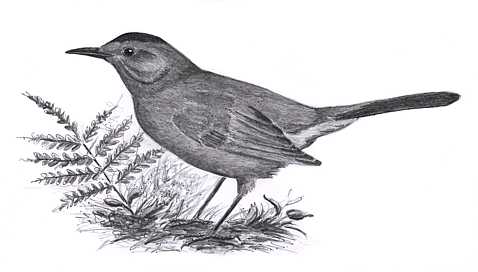
Dear Bird Folks:
This summer I have just fallen in love with the catbirds in my yard. Could you please tell me something about these wonderful birds and what I could do to keep them around?
Rachel, Falmouth
I’m with you Rachel,
Catbirds are wonderful birds. They are my third favorite bird, just below chickadees and the eagle that is on the $100 bill. Even with the awful word “cat” in their name, it is hard not to like these special birds.
There are a few species of catbirds in the world, but the one in your backyard and all of North America is the gray catbird (or grey catbird for you British visitors). The catbird, like the mockingbird, is a mimic, incorporating its own calls with other environmental sounds and calls of other birds. Unlike the clear, repeated songs of a mockingbird, the catbird’s song is a jumble of disjointed notes and squeaks. Somewhere in that mixture of notes you will hear the bird’s trademark “meow” call that gives the bird its accurate but ironic name.
Like many of our birds of summer, most catbirds spend their winter living the good life in Central America. However, unlike many of the skittish returning songbirds that hide out at the tops of trees or take off the second we spot them, catbirds seem to actually like people. (Evidently they haven’t gotten the word about us yet.) Catbirds approach humans seemingly interested in what we are doing, all the while softly chatting with such sincerity that they appear surprised when we don’t answer back.
For those of you who don’t know, catbirds are a sleek bird, not much larger than an oriole and not nearly as colorful. The name gray catbird does them perfect justice. Except for a black cap and a chestnut patch under the base of the tail, the catbird is gray all the way. The birds are so comfortable with the gray look, that both male and the female birds have chosen the exact same outfit, making them identical.
Catbirds aren’t fond of deep woods. They like broken forest edges and hedge rows. Since breaking up the forest is what people do best, catbirds are often found near humans. And as any fruit grower will tell you, catbirds love fruit. Years ago, I made the mistake of trying to grow and actually eat high bush blueberries. The catbirds couldn’t have been happier. In a fit of selfish greed, I covered the blueberry bushes with netting. Well, my net worked great for all the birds except for this one catbird. No matter what I did or how I adjusted the net, that one bird always found a way into the bushes. Then, during one out-of-control fit to keep this bird out of my blueberries for good, I humbly discovered the reason the catbird kept finding a way under my net. It was not trying to eat berries, Mrs. Catbird was just trying to get to her babies that were hidden in a nest in my blueberry bush. I immediately took the evil net down and sent it off to Vegas so the showgirls could make stockings with it.
Besides their lust for blueberries, catbirds will also eat grape jelly and oranges like the orioles do. Another real good way to attract them is with raisins. A dish of dried old raisins seem to be irresistible to catbirds. Water also is appealing to them. Water is important for bathing and to help wash down those dried old raisins.
Your catbirds will be here all summer, Rachel, then they’ll head south for the winter. I’m glad you like these neat birds, because I sure like them too. Remember to try putting out raisins some time, they work great. However, if you run out of raisins, don’t put out chopped up prunes. I tried that once and my neighbor and her laundry are still mad at me.